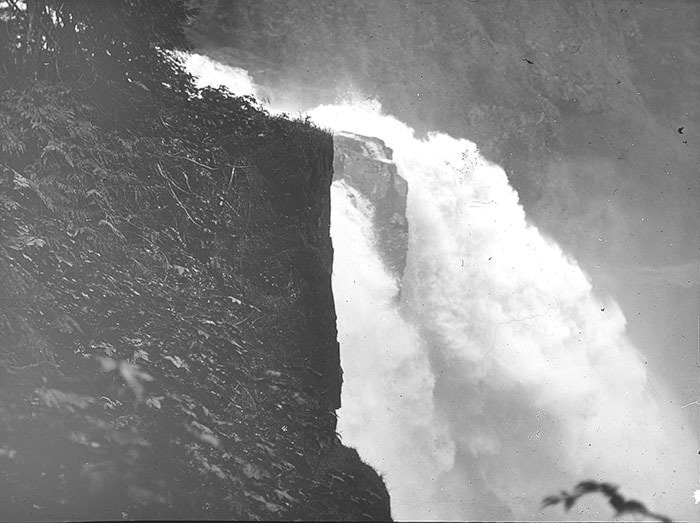By Catherine Gilbert
Museum at Campbell River
“…surely the government could arrange to set aside a small acreage round Elk Falls that exquisite work of God, set in the giant forest. If the Beauty of the falls is destroyed, if the whole length of the Island Highway is an array of blackened stumps, what is to attract the tourist?”
This excerpt from an article in the Comox Argus of April 3, 1924 entitled ‘While There is Time’ echoes the sentiment of the times. Both the inviting stands of timber in what is now known as Elk Falls Park, and the power potential of the falls themselves had been eyed by developers as early as the 1880s. Yet the natural beauty of the falls and surrounding forest were also considered to be a significant draw to tourists.
Stories appeared in the local newspaper from 1919 onward about the need to improve the road to the falls and erect proper signage. By 1920, steps were already being taken to preserve an area around the falls as parkland.
The Argus reported that “‘a resolution was passed asking the provincial government to set aside an area round Campbell River Falls for a park and not to permit the scenic beauty of the Falls themselves to be ruined by the diversion of their waters for commerce.”
It goes on to say “one of the great charms of the Falls is that they are surrounded by giant trees, typical of Vancouver Island’s primaeval forest… any logging operations or other commercial enterprise must necessarily irredeemably rob this valuable asset of its natural features.”
Locally, the falls were often referred to as the Campbell River Falls and were not officially named Elk Falls until 1952.
Concerned citizens were especially worried that if the falls were harnessed for electrical power and their force diminished, then visitors would no longer be interested in coming to see them. An indignant writer made this amply clear in a letter to the editor of the Comox Argus in 1922:
“If the public does not insist that the government should set apart an area around the Campbell River Falls as a park they will deserve to be called – and justly – vandals of the grossest and dollar-mad fools, unworthy of a great inheritance… once the beauty of Campbell River Falls is profaned, it is gone forever.”
Six years later, another writer noted that “the plea for a park at Elk Falls has been allowed to lapse” and it wasn’t until 1938 that a delegation speaking with the premier and cabinet was successful, and “their plea that small stands of timber be left and converted into beauty spots had been heeded.” (Comox Argus May 19, 1938). Finally, the province designated 1,124 hectares of land adjacent to the Campbell and Quinsam rivers as a Class ‘A’ provincial park, and on December 20, 1940, Elk Falls Provincial Park came into being.
During the 1930s, the Forestry Service had been employing out of work men to make improvements such as building bridges and pathways to make the approach to the falls safer and more easily accessible. A tearoom known as the Den served refreshments. When the workers also helped fight the devastating Great Fire that swept through the area in 1938, they were credited with saving many of the old growth trees that still surround the immediate area around the falls and canyon.
The trees may have been left intact, but the falls themselves were to undergo a radical change. In 1929, the Vancouver Island Power Corporation applied for a water licence in Campbell River, but it wasn’t until 1938 that rumours of development were circulating in earnest. It was viewed that there was potential for a pulp and paper mill in Campbell River, if adequate power could be supplied.
A 1948 travel guide noted that “most people outside British Columbia think of Campbell River as the home of the Tyee salmon but… the little town is now inspired by a new destiny which will make her even more widely known.” The writer was referring to the recent construction of the John Hart Dam, named after the province’s premier, that would supply power not only locally but as far as Nanaimo and Port Alberni.
By 1952, the Elk Falls Mill was constructed and growth of the town and its economy was ensured.
Today, the falls still attract many sightseers and Elk Falls Provincial Park also provides camping. With recent heavy rainfall, BC Hydro has had to release excess water from the John Hart reservoir, creating a magnificent flow, and visitors can once again enjoy the historic splendour of the falls.
When H.C. Johnston viewed the falls in 1910, he wrote: “And the falls! It not only compares well with those other wonders of a continent and the world in height of fall and volume of water and therefore in majestic grandeur and the wonderful tales it has to tell of the elemental forces of nature, but in wildness and beauty of surrounding it far outrivals the Niagara of today.”
The Museum at Campbell River in partnership with BC Hydro has a new permanent exhibit at the Museum outlining the history of the entire Campbell River Watershed, and Museum staff are on hand at BC Hydro’s John Hart Interpretive Centre which houses a history of the building of the dam as well as an explanation of current upgrades.
